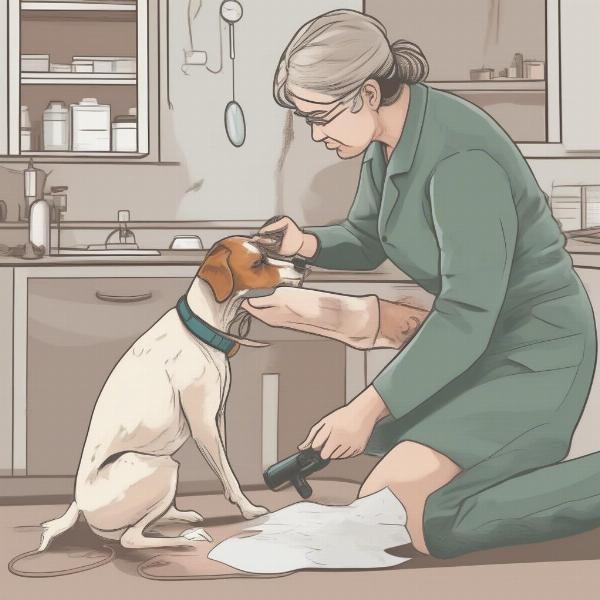Flea and worming treatment for dogs is a crucial aspect of responsible pet ownership. Protecting your canine companion from these parasites is essential for their overall health and well-being. This guide provides everything you need to know about effective flea and worming treatment, from understanding the different types of parasites to choosing the right products and implementing a preventative schedule.
Understanding the Importance of Flea and Worming Treatment
Fleas and worms can cause a range of health problems in dogs, from skin irritation and itching to serious internal infections. Fleas are not only a nuisance, but they can also transmit diseases and cause allergic reactions. Internal worms, such as roundworms, tapeworms, and hookworms, can lead to malnutrition, anemia, and even organ damage. Regular flea and worming treatment is the best way to protect your dog from these harmful parasites.
Choosing the Right Flea and Worming Products
There are many different flea and worming products available for dogs, including topical treatments, oral medications, and collars. The best product for your dog will depend on their age, weight, breed, lifestyle, and the specific parasites prevalent in your area. It’s important to consult with your veterinarian to determine the most appropriate and effective treatment plan for your dog.
Topical Treatments
Topical treatments are applied directly to your dog’s skin, typically on the back of the neck. These products usually provide protection against fleas and ticks for several weeks.
Oral Medications
Oral medications are given by mouth, either as a chewable tablet or a liquid. These products are effective against various internal parasites and some also offer flea protection.
Collars
Flea and tick collars release insecticide slowly over time, providing continuous protection for several months. Some collars also offer protection against certain types of worms.
Establishing a Preventative Schedule
A regular preventative schedule is essential for keeping your dog free from fleas and worms. The frequency of treatment will depend on the product you choose and your dog’s lifestyle. Your veterinarian can recommend a suitable schedule based on your dog’s individual needs and risk factors.
What if I forget a dose? Don’t worry! If you miss a dose, simply administer the treatment as soon as you remember and resume the regular schedule.
Signs of Flea and Worm Infestation
Even with regular preventative treatment, it’s important to be aware of the signs of flea and worm infestation. These include excessive scratching, hair loss, skin irritation, vomiting, diarrhea, weight loss, and a pot-bellied appearance. If you notice any of these symptoms, consult your veterinarian immediately.
 Veterinarian checking a dog for fleas and worms
Veterinarian checking a dog for fleas and worms
Addressing Common Concerns
How long between worming and flea treatment for dogs?
This can depend on the specific products used. It’s best to consult your veterinarian or the product instructions for guidance.
Are there natural remedies for fleas and worms?
While some natural remedies may offer some repellent properties, they are often not as effective as conventional treatments. Discuss any natural remedies you are considering with your veterinarian.
Conclusion
Flea and worming treatment for dogs is a vital part of responsible pet ownership. By understanding the different types of parasites, choosing the right products, and implementing a consistent preventative schedule, you can protect your dog from these harmful pests and ensure their long-term health and happiness. Remember to consult with your veterinarian for personalized advice and recommendations.
FAQ
- How often should I treat my dog for fleas and worms? The frequency depends on your dog’s individual needs and the product you use. Consult your veterinarian for a personalized recommendation.
- Can humans get worms from dogs? Yes, some types of worms can be transmitted from dogs to humans. Good hygiene practices, such as washing your hands after handling your dog, are essential.
- What are the signs of tapeworms in dogs? Signs of tapeworms can include rice-like segments in the dog’s stool or around their anus, as well as anal itching.
- Are flea collars safe for dogs? Most flea collars are safe when used as directed. However, some dogs may experience skin irritation or other side effects.
- Can I use cat flea treatment on my dog? No, never use cat flea treatment on a dog. Some ingredients in cat flea products are toxic to dogs.
- What should I do if my dog has a severe flea infestation? Consult your veterinarian immediately for advice and treatment. They may recommend a combination of treatments, including environmental control measures.
- Can puppies get worms? Yes, puppies can be born with worms or become infected through their mother’s milk. Regular worming is crucial for puppies.
ILM Dog is a leading international dog website dedicated to providing expert advice on dog care and wellbeing. We offer a comprehensive range of resources on dog breeds, health, training, nutrition, grooming, and much more. Whether you’re a first-time dog owner or an experienced handler, ILM Dog is your go-to source for reliable and practical information. For personalized advice, contact us at [email protected] or call +44 20-3965-8624.